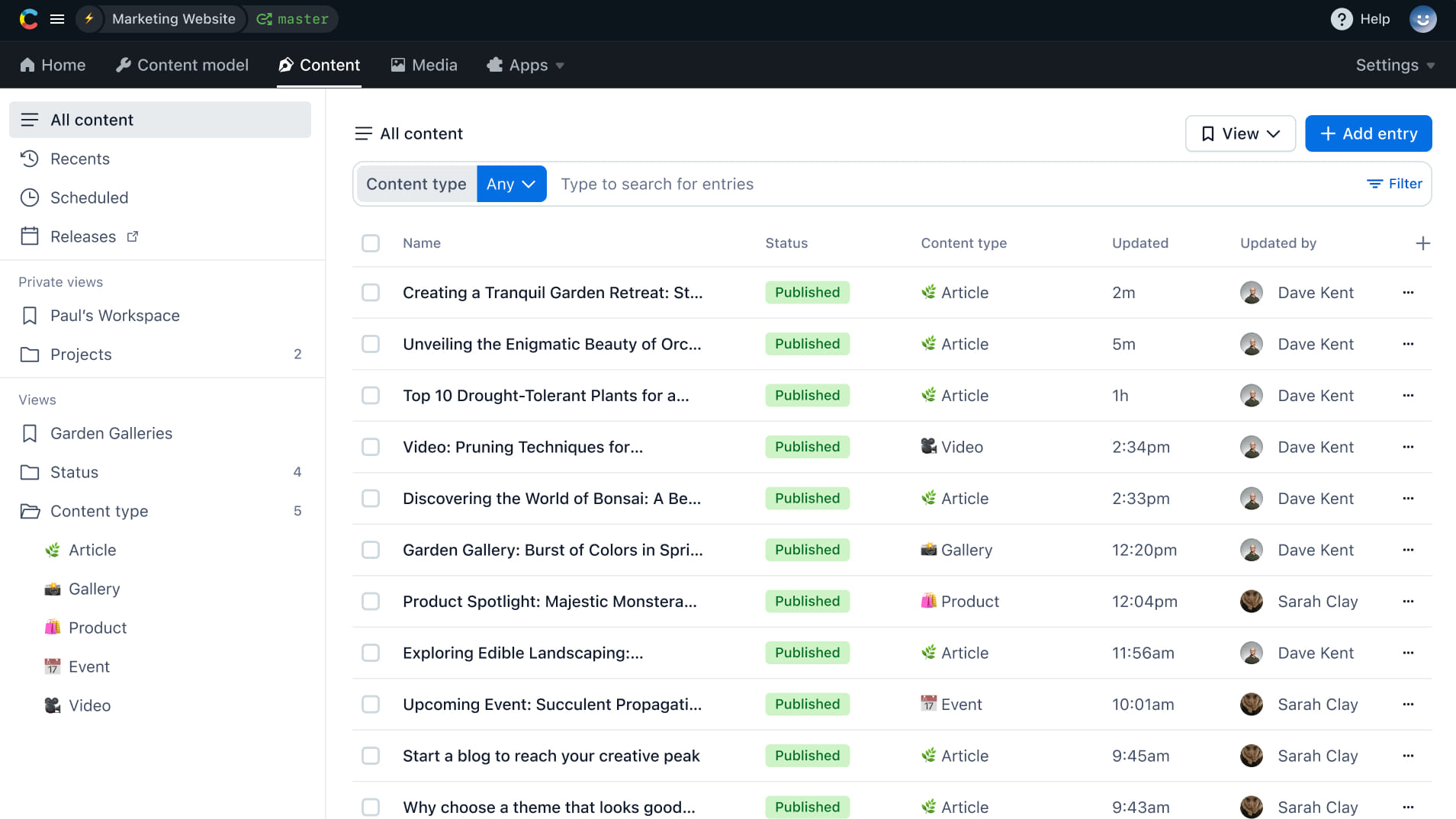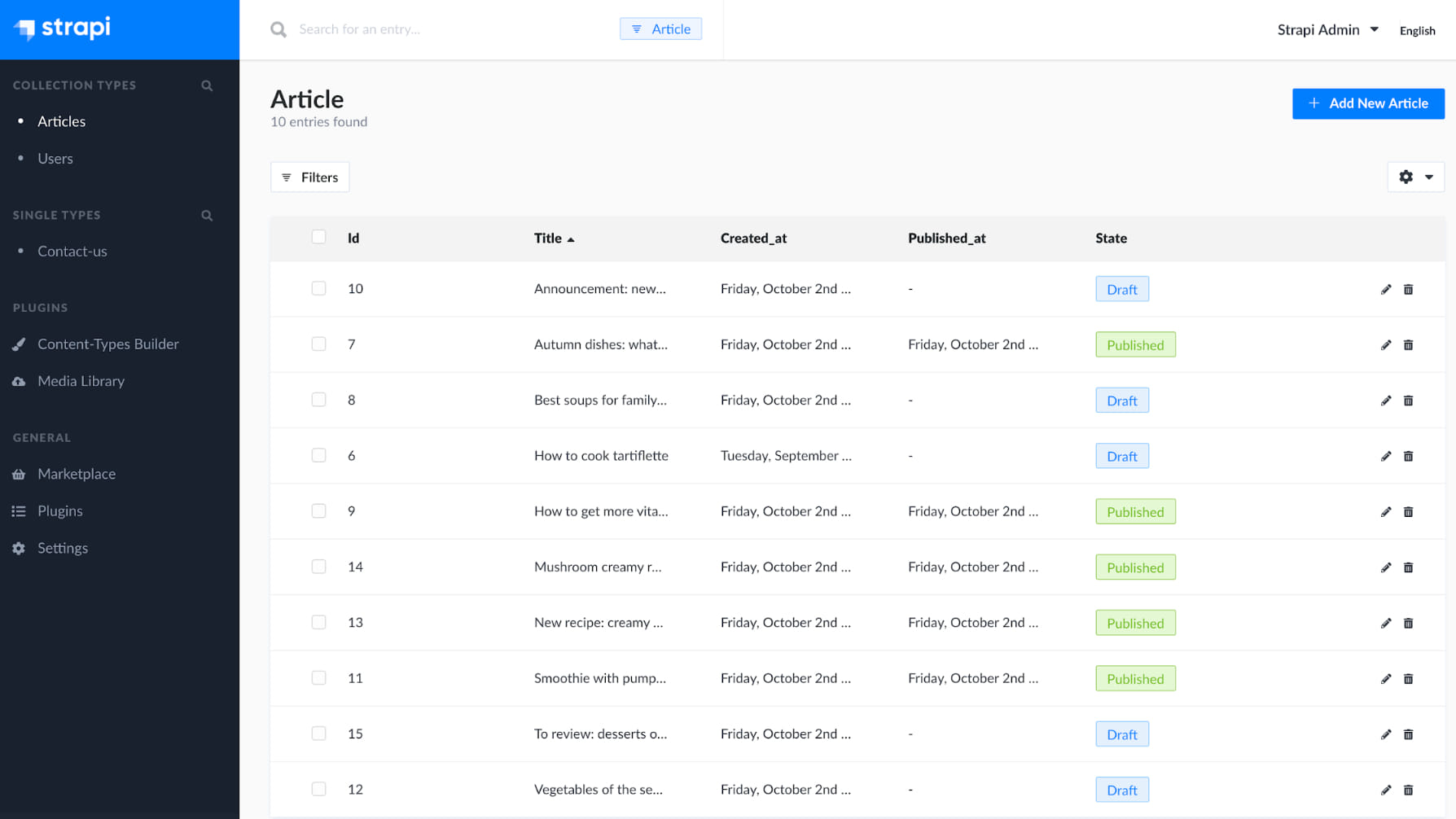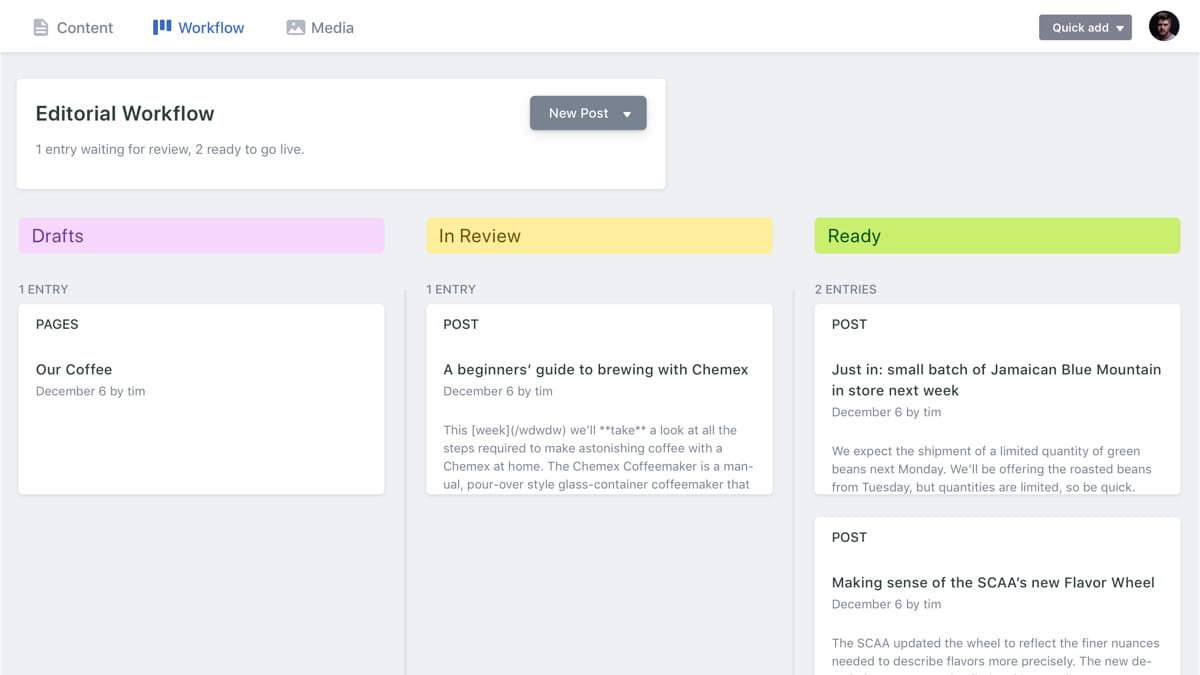Explaining Headless CMS (Content Management System)
It is typical to pivot the product iterations around the content while developing a new product or supporting an existing one. Doing A/B testing of copy against analytics or replacing images involves marketing and design departments elaborating on the content. Involving developers in every content tweak rapidly becomes expensive and time-consuming. Headless CMS allows content specialists to introduce copy changes without affecting development processes by separating static text from the codebase and using visual tools for convenient and quick iterations.
Learn more about MVP development and its foundational principles in our comprehensive guide to MVP in Software Development, where we delve into strategies for efficient product iteration and rapid deployment
Advantages of Choosing Custom Software Development With Headless CMS
Custom software development expands into various platforms that call for quick iterations and needs in delivering content. Customers expect to see company updates, news feeds, blog posts, or marketing banners up to date. Keeping the content updated regularly in your software product is no secret to increasing user engagement and improving retention metrics. A global website, a mobile app that shares a similar text content with the web app, or a marketing campaign stretching over to software and physical devices. These are prime examples of when Headless CMS comes in clutch by bringing unbeatable advantages.
- A growing business serves more clients involving development for various platforms, including web, mobile, and the Internet of Things. Imagine writing the same piece of content for all of them. It would cause content duplication, waste of resources, and hinder business growth. Headless CMS allows for a single omnichannel deployment to resolve the mentioned issues.
- Distributing global content requires managing numerous languages. With the ability to extend the functionality of CMS and with its centralized data storage, the task becomes achievable. The product team can opt-in for automated translation of content, letting non-technical specialists edit the copy in the primary language only.
- Some Headless Content Management Systems are open-source and have comprehensible documentation with responsive customer support, thus allowing product developers to integrate third-party services to better-fit business needs or customize the editorial experience.
- Real-time collaboration tools will be beneficial if new material needs team attention before publishing to collect feedback. Many content management systems include comments, content revisions, and live previews of the App supported out-of-the-box.
- In the case of product development with a Traditional Content Management System, when the content is stored closely to the codebase, it is not the best approach when it comes to maintenance and development over a broad period. Headless CMS decouples content from the codebase for easier maintenance and to gain more advantages in the long term.
- Eliminating the need to involve developers in shipping the copy enables autonomous iterations and quick adjustments led by the marketing department or other non-technical individuals.
- Increasing or surging the number of supported platforms may happen to the product at any time. Successful businesses adapt to rapidly changing market conditions, so being platform-agnostic is a significant competitive advantage and a solid step in future-proofing the product.
API-First Headless CMS and Git-based Headless CMS
The development approach with Headless CMS in the pipeline is not so different from editing the content outside of the code and independently from developers. The product team should know when to use API-first or Git-based CMS to benefit from it. They both share a similarity of serving multiple platforms as destinations but still have different use cases. We will review their pros and cons to ease the decision fatigue.
API-First Headless CMS Pros and Cons
API-first Headless CMS allows developers to retrieve the copy through network calls. CMS is hosted online and acts as a server that communicates with the database, making it easier to distribute the content uniformly among various platforms.
Pros:
- Instantaneous Delivery: Updated content appears immediately on destination platforms. Therefore, tweaking an existing copy or adding fresh material is made with the minimum delay.
- Real-time Collaboration: Managing drafts, leaving inline comments with the ability to tag people, and sharing unpublished content for feedback brings a more collaborative approach to the team.
- Role-based Access: Restricting permissions allows for granular access control and enables collaboration on different levels of responsibility.
- In-built Database: API-First Headless CMS is built around the database, offering a robust way of retrieving and storing the content.
- Customer Support: Many CMS solutions offer freemium and paid plans and do their best to retain customers and provide comprehensive technical support.
- Built-in Tools: Aside from hosting the content, it is also common for API-First CMS to have in-built image optimization, automatic content translation, scheduling content publications, and other tools supported out of the box.
Cons:
- Limited Seats: Growing products require more team members to collaborate in content iterations, inevitably leading to buying extra user slots to access the CMS.
- Higher Costs: Premium plug-ins and customer support, managing multilingual content, and hitting bandwidth usage limits can ramp up the price to utilize API-first CMS in the development. Even with self-hosted CMS, infrastructure management can be costly.
- Migration Difficulties: Starting with the favorite Headless CMS vendor, it quickly becomes the primary content source for various platforms. So it happens that the more extensive the integration with the specific CMS, the more complexity of changing it along the product development.
- Expert Setup: API-First Headless CMS provides flexible integration, requiring expertise from developers and their experience with Headless content delivery configuration for further maintenance.
- Risks of Downtime: Investigate the system uptime and seasonality of its downtime before choosing a trusted API-First CMS option. As for the critical cases, the system with frequent downtime can be a turnoff.
API-First Headless CMS Options
1. Contentful

Contentful is a robust cloud-based CMS offering a generous free tier to get started with up to two different languages for the content, plenty of handy out-of-the-box extensions, role-based authentication, responsive customer support, and fast CDN.
2. WordPress

Even though WordPress is mistakenly considered pure Traditional CMS, the perception changed after developers explored the benefits of going full-in Headless utilizing its API. An exhaustive list of plug-ins, broad community support, and intuitive editorial experience outweigh the need to find a proper VPS to host the server.
3. Strapi

Strapi is the easily recognized open-source API-first Headless CMS. It is a solid choice for flexible development by getting community recognition over the years and becoming a potent self-hosted Headless CMS solution. However, Strapi lacks the great rich-text editor that WordPress and Contentful can boast.
API-First Headless CMS is a robust content management choice, offering out-of-the-box handy tools and in-house customer support. It is suitable for larger or scaling product teams deciding on custom software development with it.
Git-based Headless CMS Pros and Cons
Git-based Headless CMS has no API to fetch the content, contrary to API-First CMS, allowing for straightforward setup and reduced costs associated with infrastructure and paid offerings.
Pros:
- Easier Setup: Since there is no backend nor database in the formula, Git-based Headless CMS alleviates the complexity of third-party services and tangled configurations.
- Git as Database: Leveraging a distributed version control system provides a robust and easy way to roll back to the previous iteration of content.
- Changes History: Git is known for its accountability in the way it tracks the changes so that it becomes clear to track adjustments throughout the documents, maintaining integrity.
- Secure: By using Git-based Headless CMS, you opt-in for the security practices holding a reputation as one of the best in the tech industry. Aside from that, content is usually fetched during build-time, protecting from real-time content retrieval vulnerabilities.
- Zero cost for Hosting: GitHub, GitLab, and Bitbucket can be used as content hosting, resulting in zero costs for nearly any project, ranging from a startup MVP and small team to a medium-sized product.
- Unlimited Bandwidth Usage: There are no bandwidth limitations during copy delivery through Git-based Headless CMS as typically associated with serving the content dynamically.
- Easily Extensible: It is flexible enough to extend the functionality to fit business needs and customize it uniquely due to being an open-source solution.
Cons:
- Lightweight: While being lightweight can be advantageous for an effortless setup, on the other hand, it is common for non-standard cases to require a tech specialist to integrate the extension or even build one from scratch.
- Difficult to Collaborate in Teams: The absence of real-time collaboration tools during content development and the need for basic familiarity with Git service can be challenging for members from non-technical departments, especially in larger teams.
- Lack of Customer Support: Git-based Headless Content Management Systems are usually open-source, restricting assistance to forums and similar channels with community help.
- Slow Deployments: Although the caching may minimize time spent on the build process, static content makes its way to the web and mobile platforms after rebuilding the App, and it happens every time the content changes.
- Not Ideal for Mobile Apps: When choosing a custom mobile development and considering the review process during the App release for the App Store and Google Play Store, content iterations stretch for a decent amount of time compared to API-based.
Git-based Headless CMS Options
1. Tina CMS (formerly Forestry.io CMS)

Lightweight and straightforward, shipped with just enough features to not overwhelm the developers but still suffice the business needs, is what makes Tina CMS favorable among other Headless CMS options for custom web apps. It also has visual editing of website elements, allowing for low-code development.
2. Decap CMS (formerly Netlify CMS)

Decap CMS is open-source and uses editorial workflow to manage unpublished content by moving from the draft to in-review to ready for publishing. Live preview for that content is available by links generated automatically. Similarly to the majority of Git-based Headless Content Management options in the market, Decap CMS is a lifetime free-to-use with unlimited seats available per account.
Picking Git-based Headless CMS covers most cases when the content is updated infrequently and gets to the customer without an external review process that may slow product development iterations. It is suitable for smaller software products, and especially marketing websites.
Use Cases for Headless CMS
- Omnichannel Content Distribution
For example, a global media company wants to publish its content across multiple platforms such as the website, mobile apps, and social media accounts, advertise in chain restaurants, and keep smart TV app users updated. Headless CMS will allow content editors to prepare material in a single place and then uniformly distribute it through the network of platforms, ensuring consistency and saving time. - Custom Mobile App Development
While developing features for a product that scales into a mobile scene, it is critical to ship intermediate updates to keep users engaged. Tweaking the content of mobile apps falls into a different category because of obligatory store reviews before releasing changes. Headless CMS unlocks the possibility of serving mobile content immediately without the need to release mobile apps. - Executing Marketing Campaigns
Marketing campaigns are a subject of frequent changes. SEO, PR, and Marketing specialists always seek convenient tools to help them launch promotional campaigns as quickly as possible, keeping consistent messaging and streamlined delivery. Contact us so our expert team can set up Headless CMS to integrate with your existing marketing tools and help your product perform better in the modern market. - Personalized Experience
Personalized user experience plays a vital role in the case of e-commerce development. Customized Headless CMS allows marketing teams to segment users by their traits to serve content exclusively to interested divisions of users. This approach opens for increased user engagement and boosted sales. - Custom Web App Development
Using low-code web app development services is enough for a hobby project. However, the modern market demands web products of a high quality that must be fast and accessible for users with diverse abilities and across various countries. Also, modern web apps should have a captivating and unique design with a streamlined content editing experience. Headless CMS elevates low-code web app development to a whole new level, ensuring top performance and consistent design throughout the website by allowing web developers to build a solid foundation to be used by non-technical specialists afterward.
Businesses Succeeding with Headless CMS
Nike

Headless CMS allows the Nike team to distribute the media content to various digital platforms, including web, mobile, and in-store digital displays.
Spotify

Spotify uses Headless CMS to provide users with personalized content and new music uploads on their smart TVs, mobile, web, and smart speakers.
Tesla

Tesla leverages the capabilities of a Headless CMS to manage content for their website, customer portals, and digital marketing campaigns.
Amazon

Amazon is a giant that benefits from content decoupling by delivering product information and customer reviews to its global marketplace.
McDonald’s

With that many restaurants in the chain of McDonald's, it is still possible to streamline in-store menu updates and local marketing campaigns thanks to Headless CMS.
If you are determined to make your business operate with Headless CMS, start building an MVP. Learn more about an MVP in software development and its importance in product development.
Conclusion
Headless CMS is known for its flexible approach for content editors to quickly and independently iterate on the content by decoupling content from the codebase. Depending on the specific use case and business requirements, you can choose between API-first and Git-based Headless CMS to help distribute omnichannel content across the web, mobile, and IoT devices. With the convenience of tools for collaboration and multi-language support, Headless CMS proves to be an industry-standard solution for custom development needs.